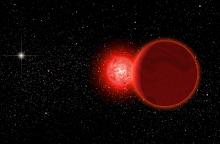Listen to today's episode of StarDate on the web the same day it airs in high-quality streaming audio without any extra ads or announcements. Choose a $8 one-month pass, or listen every day for a year for just $30.
You are here
Moon and Jupiter
When you look into the night sky, it’s a lot like watching some “live” TV and radio programs: there’s a slight delay. TV and radio do it in part to comply with federal law — it allows them to screen out certain offensive material. The night sky does it to comply with the laws of physics.
Consider the Moon and Jupiter, the solar system’s largest planet, which keep company all night. Jupiter looks like a brilliant star. It’s to the left of the Moon in early evening, and closer above the Moon at first light.
Because of the time lag, we don’t see the Moon and Jupiter as they looked at the same moment. Instead, the light from Jupiter takes more than a half hour longer to reach us.
That’s all because of the speed of light, which is limited. It’s a very high limit — about 670 million miles per hour. In fact, nothing in the universe can go faster.
But even at that incredible speed, it takes time for light to cross the great distances between worlds. The Moon is closer to us than any other astronomical object — less than a quarter of a million miles away. So light from its surface takes about one and a quarter seconds to reach Earth.
Jupiter is a lot farther — about 370 million miles right now. So its light takes about 33 minutes to reach us. In other words, when you look at Jupiter, you’re seeing the giant planet as it looked about 33 minutes earlier — a time delay mandated by the laws of physics.
Script by Damond Benningfield






